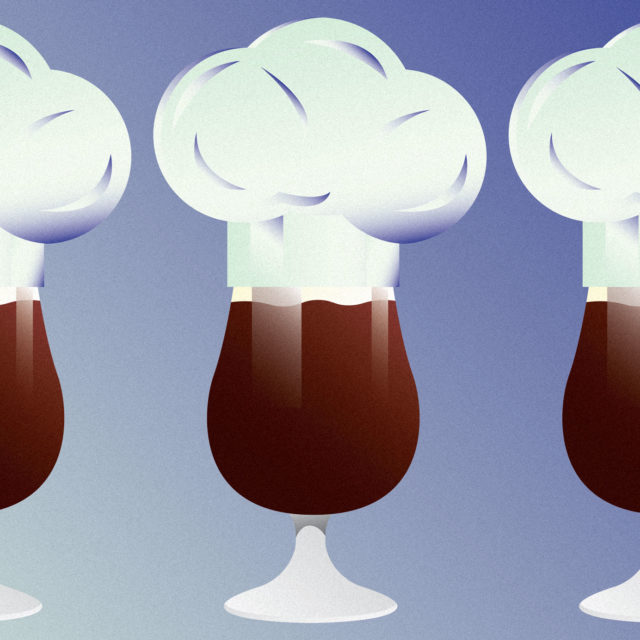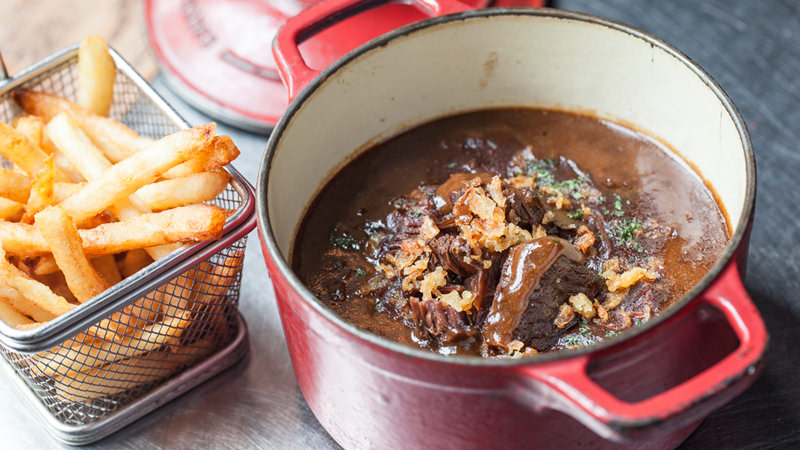If you’ve already mastered beef bourguignon and wowed your friends with your coq au vin, now might be time to ditch the wine and turn your sights to beer. No savory stew better highlights the wonders of cooking with beer than Carbonnades à la Flamande.
“It’s a very classic dish in Belgium,” Klaas Claes, Belgian-born chef and owner of BXL Zoute restaurant in Manhattan, says. “It’s something your grandma makes and you look forward to the whole week.”
Occasionally shortened to Carbonnade Flamande, or simply Carbonnade, the traditional Flemish stew braises tougher cuts of beef in Belgian or Belgian-style dark ale. Preparation of the dish is similar to beef bourguignon, but its flavor profile has a more pronounced sweet-and-sour tang.
“A bit of brown sugar masks the beer’s slightly bitter quality, and a little vinegar at the end gives character,” Julia Child writes of Carbonnade in “Mastering the Art of French Cooking.”
Modern chefs, however, often choose to omit these profile-altering ingredients. When cooking with Chimay Blue, his preferred beer for Carbonnade, Claes doesn’t feel like the dish needs sugar or vinegar. And if he’s cooking with Leffe Brune, a smoky brown ale with a more pronounced bitterness, he simply adds chopped dried prunes for a touch of sweetness.
“Some people even cook it with dark gueuze beers,” Claes says, but the spontaneously fermented sour ales provide a flavor that’s a bit too “funky” for his personal preferences.
Perhaps it’s a sign of changing attitudes toward beer over time, but notable historic recipes seem to overlook the importance of which brews to use and why.
In the 1938 “Larousse Gastronomique,” widely considered the classic cooking bible, the recipe simply calls for 600 milliliters of “beer.” In “Mastering the Art of French Cooking,” Child lists “light beer, Pilsner type,” which is a much lighter, crisper style than the dark ales popular in Belgium.
Methods for thickening the sauce have also evolved over time. “Larousse” directs chefs to enrich the stew using a brown roux, a now-dated and barely used mixture of roasted flour and butter. Child opts for cornstarch or arrowroot, which can improve the texture of the sauce but are tricky to work with and do little for the dish’s flavor.
For a simple alternative that also adds a nice kick to the dish, Claes recommends spreading a dollop of quality mustard on a thick piece of bread, then floating it on top of the simmering stew before stirring it into the sauce after 15 or 20 minutes.
Beef, of course, is another important consideration. This is a braising dish, cooked long and slow, so tougher cuts are essential. Chuck, which is cut from the cow’s shoulder, or mock tender, a steak carved from the back of the animal, are ideal. Classical cooking lore suggests that marinating the meat overnight in your preferred brew will enhance its flavor and also begin a tenderizing process, though this is a topic of debate. It’s definitely not something you should worry about if you don’t have the time.
When the time finally comes to serve, there are no hard and fast rules regarding side dishes. “In Belgium, we eat it with fries and mayonnaise, and sometimes a little endive salad,” Claes says. A robust, tangy sourdough, on the other hand, is a simple yet delicious accompaniment that proves its worth when you’ve eaten all the solid ingredients and are left with a bowl of dark, liquid gold.
“As they say in French, ‘les goûts et les couleurs on ne discute pas,’ — it’s not up for discussion, whatever you like, you like, and whatever I like, is what I like,” Claes says.
Carbonnades à la Flamande
(Recipe courtesy of Klaas Claes, BXL Zoute)
Serves 4
Ingredients:
- 2.2 pounds beef mock tender, cut into 1 ½ inch cubes
- 1 tablespoon butter
- 1 large Spanish onion , chopped
- 1 teaspoon tomato paste
- 2 12-ounce bottles Belgian dark ale, such as Chimay Blue
- 1 bay leaf
- 1 slice brown bread
- 1 tablespoon sharp mustard , such as Dijon
- Salt and ground pepper , to taste
- Optional: 1 handful chopped dried prunes, or 1 tablespoon sirop de liege (pear jelly)
Directions:
- Preheat a cast-iron casserole over medium-high heat. Season beef with salt and pepper.
- Add butter to the casserole. When it sizzles, add the beef to sear.
- When all the beef is browned, add the chopped onion and sweat over a medium heat for 2 minutes.
- Add tomato paste and cook for 1 minute, stirring regularly so it doesn’t burn.
- Add the beer and stir well.
- When the sauce starts to simmer, spread the mustard on the bread and lay it on top of the stew. Add the bay leaf and simmer for a good 10 minutes before covering the pot. If you’re adding sirop de liege or dried prunes, now is the time.
- Stir the now-soaked bread into the sauce and cook for another 20 minutes. Check the meat to see if it’s nice and tender. (Depending on the quality of meat, it may require further cooking.)
- When the meat is tender, take the pot off the stove and let it cool down without a lid.
- Serve with fries, mayonnaise, and a little endive salad. For the best results, let the Carbonnade sit overnight, storing in the refrigerator, and serve the following day.

